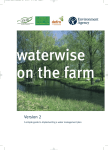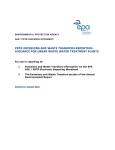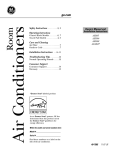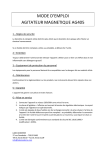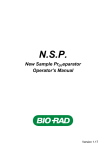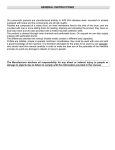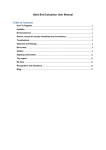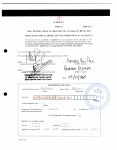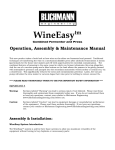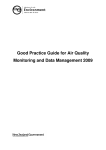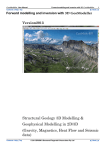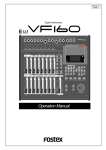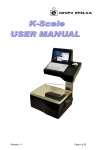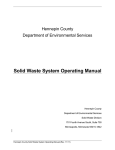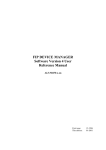Download User`s manual
Transcript
JOINT RESEARCH CENTRE Institute for Prospective Technological Studies (IPTS) Sustainable Production and Consumption Unit European IPPC Bureau FDM questionnaire User's manual Document explaining how to fill in the questionnaire for the data collection in the review of the Food, Drink and Milk Industries (FDM) BREF Workshop draft version Edificio Expo, C/ Inca Garcilaso, 3 – 41092 Seville, Spain Telephone: +34-95 44 88 284 Fax: +34-95 44 88 426 E-mail: [email protected] Internet: http://eippcb.jrc.ec.europa.eu/ Review of the FDM BREF - Questionnaire user's manual 1 INTRODUCTION 3 2 GENERAL INSTRUCTIONS 3 3 STRUCTURE AND CONTENT OF THE QUESTIONNAIRE 4 3.1 COMMON SHEETS FOR ALL THE FDM SECTORS 3.1.1 "1. INSTALLATION ID" SHEET 3.1.2 "2. POINTS OF RELEASE" SHEET 3.1.3 "3. ROCESS INTEGRATED TECHNIQUES" SHEET 3.1.4 EMISSIONS TO AIR SHEETS 3.1.5 "5. DIFFUSE AIR EMISSIONS" SHEET 3.1.6 "EMISSIONS TO WATER" SHEETS 3.1.7 "8. WATER CONSUMPTION" SHEET 3.1.8 "9. ENERGY CONSUMPTION" SHEET 3.1.9 "10. RESIDUES" SHEET 3.1.10 "11. CLEANING" SHEET 3.2 SECTOR SPECIFIC SHEETS 3.2.1 DAIRY SECTOR 3.2.2 SUGAR MANUFACTURING 3.2.3 FRUIT AND VEGETABLES 3.2.4 MEAT PROCESSING 3.2.5 ANIMAL FEED 3.2.6 OILSEED PROCESSING AND REFINING 3.2.7 STARCH PRODUCTION 3.2.8 BREWING 3.2.9 FISH AND SHELLFISH PROCESSING 3.2.10 OLIVE OIL PROCESSING AND REFINING 3.2.11 SOFT DRINKS AND JUICE MADE FROM CONCENTRATE 3.2.12 GRAIN MILLING 3.2.13 ETHANOL PRODUCTION 5 5 5 ERROR! BOOKMARK NOT DEFINED. 9 11 ERROR! BOOKMARK NOT DEFINED. 14 15 15 15 15 16 16 16 16 17 17 18 18 18 18 19 19 19 4 HOW MANY QUESTIONNAIRES SHOULD BE PROVIDED 19 5 BAT CANDIDATES 19 5.1 ECONOMIC DATA 20 6 PRACTICALITIES FOR THE USE OF THE QUESTIONNAIRE 21 6.1 PRINTING THE QUESTIONNAIRE 6.2 ATTACHING ADDITIONAL FILES TO THE QUESTIONNAIRE 6.3 ADDITIONAL EXPLANATIONS 7 GLOSSARY 2 21 21 ERROR! BOOKMARK NOT DEFINED. 22 Workshop draft version EIPPCB/FDM BREF Questionnaire User's Manual 1 INTRODUCTION The primary purpose of the questionnaire is to collect data to derive the Best Available Technique (BAT) conclusions for the revised version of the FDM BREF. In consideration of the key environmental issues of the industrial sector (identified at the kick-off meeting), this questionnaire is focused on the emission levels with a view to deriving the BAT-associated environmental performance levels (BATAEPLs), including BAT-associated emission levels (BAT-AELs). Especially for emissions to air and to water, contextual information on how the data are obtained is imperative for deriving meaningful conclusions. The data collected will be used to review the 'Current emission and consumption levels' and 'Techniques to consider in the determination of BAT' chapters of the FDM BREF. Several of the kick-off meeting conclusions are focused on collecting additional (bulk) information on different environmental issues, e.g. thumbnail descriptions for some FDM sectors, specific techniques, cooling systems, environmental risks, odour and noise, energy efficiency. This information will be collected either by using the BAT candidate template or by not using any template. The list of topics for which additional information should be provided has been also posted onto BATIS: Forums > Food, Drink and Milk Industries > 02 First FDM BREF review 2014- > 08 Information collection Questions included in the questionnaire have been proposed taking into consideration the importance of the data requested for the FDM BREF review process, as well as the availability of the data (and the time the operator will need to provide the data). 2 GENERAL INSTRUCTIONS The questionnaire should be completed on a personal computer equipped with Microsoft Excel. Please use the proposed drop-down menus and predefined options wherever possible; free text fields are available throughout the questionnaire to provide further explanations (comments, additional information fields). When filling in the fields, the values must not be inserted by expanding the series (i.e. it is not recommended to use the drag&drop built-in Excel feature). The zooming embedded Excel function can be used to magnify specific questionnaire sections. Detailed instructions and guidance are provided within the tooltips attached to most of the questions. When answering the questions, please always read the corresponding tooltips (hover the mouse over the question) to check how the data should be provided (sometimes the questionnaire allows you to provide data in different formats): If the provided data are estimated (i.e. not based on measurements performed during the reference year), please indicate that this is the case in the 'Additional information' cell in the corresponding sheet. Some data may not be available, so in this case please use the abbreviation 'NA' or leave the field empty and indicate the reason in the 'Additional information' fields. If some data are available 3 Workshop draft version EIPPCB/FDM BREF Questionnaire User's Manual but cannot be presented in the format specified in the questionnaire, the corresponding cell should also be marked 'NA' and you should report this in the 'Additional information' cell. Please note that according to Directive 2010/75/EU on Industrial Emissions (IED), emission levels associated with best available techniques (BAT-AELs) apply only for normal operating conditions, but the same directive specifies that permit conditions shall include measures relating to other than normal operating conditions (OTNOCs). Therefore, although the focus of the questionnaire is on emissions during normal operating conditions, some additional information on OTNOCs are also deemed necessary for the correct understanding of the overall plant performance. All the data reported in the questionnaire should refer to the reference years (2012, 2013, and 2014). Year 2014 is marked in bold font, as the most updated data are preferred. Please try to provide data expressed according to the units proposed in the FDM questionnaire, in view of deriving potential BAT-AEPLs (including BAT-AELs) in a more homogeneous way. If data are not available for that/those year(s) or if they do not appropriately represent the normal operational conditions (e.g. due to a major breakdown), you may use data from other recent years, indicating which year in the questionnaire. Some parts of the questionnaire may appear 'blank'. The questionnaire is designed (through macros and conditional formatting) so that, depending on the answers to some of the questions, certain parts of the questionnaire (e.g. sheets, lines of tables, drop-down menu entries) which are not of interest for the reference plant filling in the questionnaire may disappear. In some questions the symbol ' appears to indicate a drop-down menu in the answer field. In most of the drop-down menus, the choice 'other' is available and explanations can be given in the additional information fields. For the correct use of the questionnaire, the macros option of Excel must be enabled. ▼ Generally, each sheet has fields for additional information, where all the complementary information regarding the filled-in data can be presented. This is especially important when the provided data do not exactly match the requested information. Furthermore, if some additional documents (e.g. graphs) are provided with the questionnaire, this should be mentioned in the corresponding 'Comments' cell. 3 STRUCTURE AND CONTENT OF THE QUESTIONNAIRE The questionnaire opens with the template information sheet (not numbered) that provides a cover page and an introduction. The questionnaire is divided into the following sheets, each focused on different aspects of the FDM installation: • • • • • • • • • • • 4 0. Introductory notes 1. Installation ID 2. Points of release 3. Air emissions info 4. Air spot sampling 4. Air other sampling 4. Air continuous 5. Diffuse air emissions 6. General info WWTP 7. Water freq sampling 7. Water periodic Workshop draft version EIPPCB/FDM BREF Questionnaire User's Manual • • • • • 8. Water consumption 9. Energy consumption 10. Residues 11. Cleaning 12. Sector-specific sheets When you do not have data to fill in a given question, you can leave the field concerned blank. The additional information fields are available for receiving considerations, e.g. on reasons for not filling in a field, reasons for not monitoring a pollutant, special local conditions. The questionnaire makes reference to the BAT candidate template, where you can provide information on techniques following a predefined structure. The BAT candidate template is available in BATIS in the following folder: Forums > Food, Drink and Milk Industries > 02 First FDM BREF review 2014- > 08 Information collection For preventive and/or abatement techniques, it is possible to give qualitative and/or quantitative information on most of the main parameters (e.g. size, removal efficiency, costs) by indicating the technique as a candidate BAT and then filling in the BAT candidate template. It is also possible to provide information on techniques that have not been included in the questionnaire by using this template. 3.1 3.1.1 Common sheets for all the FDM sectors "0. Introductory notes" sheet In this sheet, basic information about the person filling in the questionnaire and/or giving assistance is requested. Sheet 0 also contains general information on the IED, the Sevilla process, the purpose of the questionnaire, what to do if you consider that any information is considered confidential and what type of information is requested. 3.1.2 "1. Installation ID" sheet In this sheet, general information about the installation is requested: installation and company name, location, FDM sector(s), IED activity(s), year of production start. From a drop-down list the operator can choose the related FDM sector (from those on which it has been concluded to collect data at the kick-off meeting). When choosing a FDM sector, only the related specific sector sheet and the specific pollutants will appear, according to the conclusions of the kick-off meeting. Additional FDM sector(s) are asked for in Section 1.4 of the questionnaire. If there are additional FDM sectors included in the same installation, separate questionnaires should be completed for each FDM sector. 3.1.3 "2. Points of release" sheet In this sheet, process information is requested about the total number of monitored points of release for both emissions to water and to air. In order to better understand the waste water 5 Workshop draft version EIPPCB/FDM BREF Questionnaire User's Manual streams/waste gas flows, the relation to the source/s (production process/es) and any waste water/air treatment systems in place, a flow diagram/layout showing these details would be very helpful. Please attach both (water and air) flow diagrams (as an annex to the questionnaire). Non-monitored points of release (e.g. discharge of run-off water) can be shown in these flow diagrams, but obviously emission data will not be collected from them. For the monitored points of release, the classification according to the applied monitoring method is requested. For emissions to water, the monitored points of release have to be further classified in two categories: • Composite sampling performed at least once a month (sheet 4) • Periodic monitoring - less than 12 measurements per year (sheet 4) For emissions to air, the monitored points of release have to be further classified in three categories: • Spot sampling - less than 12 measurements per year (sheet 4) • Other sampling - 12 or more times a year (sheet 4) • Continuous monitoring (sheet 4) According to the kick-off meeting conclusions, some sectors have to provide data on emissions to air from specific points of release: dryers, smoke kilns, raw material preparation and extrusion. The questionnaire is customised and shows only those specific points according to the FDM sector specified in sheet 1. Please remember that ONLY on-site combustion plants generating hot gases that are used for direct contact heating, drying or any other treatment of objects or materials are included in the scope of the FDM BREF. The questionnaire automatically generates the following sheets related to emissions to water: - Value of cell C12 will generate the corresponding number of sheet '6. General info WWTP'. - Value of cell D12 will generate the corresponding number of sheet '7. Water freq sampling'. - Value of cell F12 will generate the corresponding number of sheet '7. Water periodic'. The questionnaire automatically generates the following sheets related to emissions to air: - Value of cell C43 will generate the corresponding number of sheet '3. Air emissions info'. - Value of cell D43 will generate the corresponding number of sheet '4. Air spot sampling'. - Value of cell F43 will generate the corresponding number of sheet '4. Air other sampling'. - Value of cell H43 will generate the corresponding number of sheet '4. Air continuous'. If the value of these cells is reduced later, a warning message will appear asking for permission to delete the corresponding sheets. The emission data requested in sheets 4 and 7 are also displayed according to the FDM sector chosen in sheet 1 and the kick-off meeting conclusions. Furthermore, the operator is requested to number the points of release and describe the process linked to each point. In this way, the points of release will be clearly identified in the questionnaire. In the following figures, some examples of flow diagrams and the required number of sheets for monitored emissions both to water and to air are given. 6 Workshop draft version EIPPCB/FDM BREF Questionnaire User's Manual Figure 1: Example of 1 unit/process discharging emissions to air through 1 point of release Figure 2: Example of 2 units/processes discharging emissions to air through 1 point of release 7 Workshop draft version EIPPCB/FDM BREF Questionnaire User's Manual Figure 3: Example of 3 units/processes discharging emissions to air through 2 points of release Figure 4: Example of FDM installation discharging emissions to water through 1 point of release 8 Workshop draft version EIPPCB/FDM BREF Questionnaire User's Manual Figure 5: Example of FDM installation discharging emissions to water through 3 points of release 3.1.4 Emissions to air sheets There are four types of sheet for emissions to air, to provide supporting information and data (according to the monitoring regime in place): • • • • The "3. Air emissions info" sheet, for providing contextual information The "4. Air spot sampling" sheet, for providing emission data The "4. Air other sampling" sheet, for providing emission data The "4. Air continuous" sheet, for providing emission data Please note (as already mentioned) that a number of data sheets will be automatically generated, according to the specified monitored points of release in sheet 2. Please also note that, with the selection of a FDM sector, only the parameters and units (concentrations and, for some parameters, specific loads) for which it was concluded to collect data at the kick-off meeting will be shown in the data sheets. Data can be reported for three reference years (2012, 2013, 2014). As a general remark, it should be emphasised that reported data should refer only to normal operating conditions. Please note that emission data are requested not only in concentrations, but also in specific loads. Data on removal efficiencies are also requested and there is a drop-down list for specifying their derivation method: - Designed value: value obtained from the equipment specifications. - Calculated value: value obtained by the difference between the inlet and outlet emission data related to the point of release. - Estimated value: value derived from surrogate parameters (e.g. pressure drop). 9 Workshop draft version EIPPCB/FDM BREF Questionnaire User's Manual Moreover, the following contextual monitoring information is requested in the sheets for providing emission data: - Sampling duration: duration of the sampling period related to the values reported for these discontinuous monitoring events. - Standard monitoring method: published or documented procedure for using the monitoring approach and technique (i.e. analytical principle, such as infrared absorption, chemiluminescence, isokinetic sampling followed by gravimetry, sorbent tube followed by gas chromatography), so that comparable results can be obtained when the monitoring is carried out at different times or by different organisations. Please report CEN, ISO or other standards, e.g. EN 13284-1 for the measurement of dust emission. - Uncertainty of a single measurement (%): the uncertainty assigned to a measured result represents the size of the region around the result in which the 'true value' is expected to lie (with certain probability, i.e. in 95 times out of 100, the result will be within these bounds); the range of dispersion is inherent to the measurement approach and technique. For each pollutant monitored the uncertainty of measurement should be reported in the form of a percentage of the measured value. - Has the uncertainty already been subtracted from the values reported in this row? Specify (YES or NO) whether the reported value is obtained directly from the calibrated measurement device, i.e. 'as seen on the device screen', or is calculated as the number 'as seen on the device screen' minus the uncertainty of the measurement in the form of a 95 % confidence interval. - Emission limit values prescribed by competent authority: please report the emission limit values in your permit and with the unit, type of average and compliance criteria (i.e. percentile or other criteria). - Additional information: when relevant, please give information on local conditions that lead to the current monitoring practice. In order to provide better insight into some specific other than normal operating conditions, if available, the operator may attach additional information (in the corresponding sheet or as an annex to the questionnaire), e.g. data excluded, graphs of the emissions, circumstances under which such a situation occurs. According to the conclusions of the kick-off meeting, data on emissions to air should not be collected for the following FDM sectors: fruit and vegetables, soft drinks and juice made from concentrate, ethanol production. 3.1.4.1 "3. Air emissions info" sheet In this sheet, contextual information for emissions to air is requested for each point of release. The operator will have to fill in as many copies of this sheet as there are monitored points of release (= value indicated in cell C43 of sheet 2). Process-integrated techniques having an influence on the emissions to air from the point of release are requested. Information is requested for the end-of pipe techniques applied in the release point through a dropdown list with all the techniques included in the current FDM BREF (including a reference to the section numbering). If other techniques are applied, these could be described with the insertion of different rows. Information is also requested for possible local conditions influencing the decision to install a special air pollution abatement technique. 10 Workshop draft version EIPPCB/FDM BREF Questionnaire User's Manual 3.1.4.2 "4. Air spot sampling" sheet This sheet should be completed when emissions to air are monitored periodically for a specific point of release, less than 12 times a year. The operator will have to fill in as many copies of this sheet as there are points of release being monitored using spot sampling (= value indicated in cell D43 of sheet 2). Information on seasonality (working months per year) and type of production (continuous or batch) related to the point of release is requested. Data on flow and O2 content on a dry basis (related to reference measurement conditions), and on key pollutants for the corresponding FDM sector should be provided. 3.1.4.3 "4. Air other sampling" sheet This sheet should be completed if emissions to air at a point of release are monitored periodically, more than 12 times a year. The difference to the previous sheet is that in this case data on averaging values (minimum, maximum, average, 95th percentile) from all the performed spot measurements are requested. The number of samples taken during the year considered for the values reported should also be provided. 3.1.4.4 "4. Air continuous" sheet This sheet should be completed if emissions to air at a point of release are monitored continuously. In such a case the difference is that minimum, maximum, averaging and 95th percentile daily and yearly averaging values should be reported. The way of obtaining the averages is especially relevant, as follows: - Daily average: the average of all daily averages (averages over a period of 24 hours based on valid measured values), excluding data referring to other than normal operating conditions, as well as periods when the plant was not operational. - Yearly average: the average of all valid values over a period of one year, excluding data referring to other than normal operating conditions, as well as periods when the plant was not operational. 3.1.5 "5. Diffuse air emissions" sheet This sheet should be used for reporting information about non-captured and non-channelled emissions to air, e.g. from storage areas, pipe network, equipment. More precisely, information should be provided for sources and types of diffuse and fugitive emissions as well as for techniques implemented to reduce them. 3.1.6 11 "Emissions to water" sheets Workshop draft version EIPPCB/FDM BREF Questionnaire User's Manual There are three general sheets for emissions to water, for providing supporting information and data (according to the monitoring regime in place): • • • The "6. General info WWTP" sheet, for providing contextual information The "7. Water freq sampling" sheet, for providing data The "7. Water periodic" sheet, for providing data As for emissions to air, a number of data sheets will be automatically generated, according to the specified points of release in sheet 2. Also again, with the selection of a FDM sector, only the parameters for which it was concluded to collect data at the kick-off meeting will be shown in the data sheets. Data can be reported for three reference years (2012, 2013, 2014). As a general remark, it should be emphasised that reported data should refer only to normal operating conditions. Please note that emission data are requested not only in concentrations, but also in specific loads (except for the water flow). The units1 for specific loads should be chosen from a drop-down list. The data reported here should refer only to normal operating conditions; data referring to other than normal operating conditions, as well as periods when the plant was not operational, should be excluded. Data on removal efficiencies are also requested. Removal efficiency can be easily calculated from the influent and effluent data, as follows: = where: EF I E − is the removal efficiency, expressed in %. is the influent data, expressed in concentration (mg/L) or specific load (kg/tonne). is the effluent data, expressed in concentration (mg/L) or specific load (kg/tonne). As for emissions to air, the following contextual monitoring information is requested in the sheets for providing emission data: - Sampling duration: duration of the sampling period related to the values reported for these discontinuous monitoring events. - Standard monitoring method: published or documented procedure for using the monitoring approach and technique, so that comparable results can be obtained when the monitoring is carried out at different times or by different organisations. Please report CEN, ISO or other standards, e.g. EN 872 for the measurement of total suspended solids. - Uncertainty of a single measurement (%): the uncertainty assigned to a measured result represents the size of the region around the result in which the 'true value' is expected to lie (with certain probability, i.e. in 95 times out of 100, the result will be within these bounds); the range of dispersion is inherent to the measurement approach and technique. For each pollutant monitored the uncertainty of measurement should be reported in the form of a percentage of the measured value. - Has the uncertainty already been subtracted from the values reported in this row? Specify (YES or NO) whether the reported value is obtained directly from the calibrated measurement device, i.e. 'as seen on the device screen', or is calculated as the number 'as seen on the device screen' minus the uncertainty of the measurement in the form of a 95 % confidence interval. 1 The units for specific loads will be discussed in the questionnaire workshop in Brussels. 12 Workshop draft version EIPPCB/FDM BREF Questionnaire User's Manual - Emission limit values prescribed by competent authority: please report the emission limit values in your permit and with the unit, type of average and compliance criteria (i.e. percentile or other criteria). - Additional information: when relevant, please give information on local conditions that lead to the current monitoring practice. Moreover, in order to provide better insight into some specific other than normal operating conditions, if available, the operator may attach additional information (as an annex to the questionnaire), e.g. data excluded, graphs of the emissions, circumstances under which such a situation occurs. According to the kick-off meeting conclusions, data on emissions to water should not be collected for the grain milling sector. In the case of animal feed, only those installations producing pet food and feed for fur animals should report data on emissions to water. 3.1.6.1 "6. General info WWTP" sheet In this sheet, contextual information for emissions to water is requested for each point of release. Emission data for the described waste water and its treatment should be reported in sheet(s) 7. First of all, any point of release should be specified through a drop-down list that includes three options: • Direct discharge to a receiving water body. This is the case when the final WWTP is included in the FDM installation, and the discharge is carried outside (e.g. to a river, estuary, sea) (see Figure 4). • Indirect discharge to a WWTP. This is the case when waste water is sent to a downstream WWTP (e.g. municipal/urban WWTP, off-site industrial WWTP) (see Figure 5). • Landspreading. Section 6.2 requests information about the water quantities entering (influent)/ leaving (effluent) the final waste water treatment plant (WWTP), and the amount of water recycled/reused from the three main parts of waste water treatment and management: 1) process-integrated techniques, 2) pretreatment and 3) the final WWTP. Section 6.3 asks for information on the volume and dry matter content of the sludge generated by the final WWTP. The destination of recycled/reused water can be specified in the additional information cells. In section 6.4, information is requested on the origin and seasonality of the waste water streams contributing to the total volume of incoming waste water that is treated in the final waste water treatment plant, expressed in % of the total influent of the final WWTP. This helps to understand the main sources of emissions to water in the installation. Process waste water refers to those streams generated from the different lines of production/process. Information on other types of waste water streams is also asked for, e.g. cleaning water, run-off water, cooling water. If there are waste water streams sent to the final WWTP from sources other than the FDM activity (e.g. slaughterhouse, large combustion plant), please provide this information in section 6.4.2. Information is requested about the implementation of the following types of technique that contribute to the reduction of emissions to water: • Section 6.5: management and process-integrated techniques applied at process level for specific waste water streams before mixing them at the final WWTP • Section 6.6: pretreatment techniques applied for specific waste water streams before mixing them at the final WWTP (selection from a drop-down list) 13 Workshop draft version EIPPCB/FDM BREF Questionnaire User's Manual • Section 6.7: treatment techniques at the final WWTP of the FDM installation (selection from a drop-down list). If the installation is performing an indirect discharge or landspreading this section will not be filled in. If there is no waste water pretreatment or final treatment, please indicate that this is the case by choosing 'no treatment' from the drop-down list of implemented techniques in sections 6.6 and 6.7. For the process-integrated (section 6.5) and pretreatment techniques (section 6.6), information is requested for contributory waste water streams and removal efficiencies for the relevant parameters. In section 6.8, information is requested on possible local conditions influencing the decision to install a special water pollution abatement technique, e.g. local water quality standards. 3.1.6.2 "7. Water periodic" sheet This sheet refers to the final WWTP and should be completed if periodic (spot or composite sampling) monitoring of emissions to water from the final WWTP is performed less than 12 times a year. Information on seasonality (working months per year) and type of production (continuous or batch) related to the point of release is requested in sections 7.1.1 and 7.1.2. Data for both the influent and the effluent of the final WWTP are requested. In this case, the values obtained directly from the monitoring/measurement should be reported. The frequency of monitoring and the type of sampling (composite sample, spot sample, other) is also requested. 3.1.6.3 "7. Water freq sampling" sheet This sheet refers to the emissions to water from the final WWTP and should be completed if water spot or composite sampling is performed at least once a month, according to the information given in sheet 2. Information on seasonality (working months per year) and type of production (continuous or batch) related to the point of release is requested in sections 7.1.1 and 7.1.2. The following statistical values for both the influent and the effluent from the final WWTP are requested: - Minimum value: minimum of the measurements taken during the year of reference. - Average value: average of the measurements taken during the year of reference. - Maximum value: maximum of the measurements taken during the year of reference. - 95th percentile: 95th percentile of the measurements taken during the year of reference. In the case of the minimum value, if the measured value is below the detection limit, then the detection limit of the monitoring method should be reported and information provided in the corresponding additional information cell (last column). 3.1.7 14 "8. Water consumption" sheet Workshop draft version EIPPCB/FDM BREF Questionnaire User's Manual In section 8.1, data on the water consumption in the FDM installation are requested: total water consumption, source and quantification of the inlet water, water consumption by use, total amount of recycled/reused water, and water monitoring system. Moreover, contextual information is requested on the techniques implemented for the reduction of water consumption and for water reuse (section 8.2). 3.1.8 "9. Energy consumption" sheet In section 9.1, data on the energy consumption in the FDM installation are requested: total energy consumption, energy consumption by source and by use, amount of energy generated from byproducts (e.g. by anaerobic digestion), and energy monitoring system. Moreover, contextual information is requested on the techniques implemented for the reduction of energy consumption and/or for energy generation. 3.1.9 "10. Residues" sheet In this sheet, information and data are requested for the main residues, wastes and by-products generated by the FDM installation and its auxiliary systems. There is a free text cell for the description of what is generated (e.g. molasses) and a drop-down list for its source and final destination. 3.1.10 "11. Cleaning" sheet In section 11.1, information is requested on the specific cleaning procedures taking place in the FDM installation: manual cleaning of surfaces, manual cleaning of equipment and/or CIP cleaning of closed equipment. Information is also asked for on techniques applied to reduce water and energy consumption for cleaning (sections 11.2 and 11.3). Moreover, the operator should provide an indication of the chemicals and other substances used for cleaning (section 11.4) and the techniques implemented for chemicals reduction (section 11.5). 3.2 Sector-specific sheets Apart from the common sheets, the questionnaire includes specific sheets for each FDM sector for which it was agreed to collect data at the kick-off meeting. As a reminder, these sectors are the following: 15 Dairies Sugar manufacturing Fruit and vegetables Meat processing Animal feed Oilseed processing and refining Starch production Workshop draft version EIPPCB/FDM BREF Questionnaire User's Manual - Brewing Fish and shellfish processing Olive oil processing and refining Soft drinks and juice made from concentrate Grain milling Ethanol production Only one sector-specific sheet (numbered as 12.) appears automatically in each questionnaire, according to the FDM sector selection in the "1. Installation ID" sheet. Generally and as a horizontal issue, information about the main raw materials and main products is requested in each sector-specific sheet. Moreover, particular information for each sector is requested, according to the conclusions of the kick-off meeting. 3.2.1 Dairies The total amount of main raw materials received and processed is asked for in section 12.1. Information on the % share of the main raw materials received and processed (section 12.1) and of the main products (section 12.2) is requested. Specific information is requested about the drying of powdered products (section 12.3): type and total amount of dried product, type of dryer and fuel used (to be selected from a drop-down list). If the drying process is linked to a monitored point of release, then the monitoring data for total dust emissions should be reported through the 'emissions to air' sheets (sheets 3 and 4). In section 12.4 (or as an attached file), a characterisation of the dust fraction should be provided (e.g. particle size distribution, moisture content, stickiness). 3.2.2 Sugar manufacturing The amount of raw materials received and processed (section 12.1) and the total amount of products and the main products' % share (section 12.2) are requested. Specific information is asked about beet pulp drying (section 12.3): total amount of dried pulp, type of dryer and fuel used (to be selected from a drop-down list). If the drying process is linked to a monitored point of release, then the monitoring data for emissions to air should be reported through the 'emissions to air' sheets (sheets 3 and 4). In section 12.4 (or as an attached file), a characterisation of the dust fraction should be provided (e.g. particle size distribution, moisture content, stickiness). 3.2.3 Fruit and vegetables The total amount of raw fruit and vegetables received and processed is requested, and additionally the share (in %) of the main raw materials and products. 3.2.4 16 Meat processing Workshop draft version EIPPCB/FDM BREF Questionnaire User's Manual The total amount of raw beef, pork and poultry meat received and processed is asked for in section 12.1. Additionally, the share of total production (in %) of the main products is requested in section 12.2. Specific information is asked about smoking (section 12.3): type and amount of smoked product, and smoking method (to be selected from a drop-down list). If the smoking process is linked to a monitored point of release, then the monitoring data for emissions to air should be reported through the 'emissions to air' sheets (sheets 3 and 4). 3.2.5 Animal feed In section 12.1, the operator should characterise the installation production (compound feed, pet food, green fodder drying, feed for fur animals) by choosing yes or no from a drop-down list. In section 12.2, the total amount of main raw materials received and processed is requested and also the % share of them. Similarly, in section 12.3, the total amount of animal feed produced is asked for and also the % share of the total amount of the main products. Specific information is asked about drying (section 12.4): type and amount of dried product, type of dryer and fuel used (to be selected from a drop-down list). If the drying process is linked to a monitored point of release, then the monitoring data for total dust emissions should be reported through the 'emissions to air' sheets (sheets 3 and 4). In section 12.5 (or as an attached file), a characterisation of the dust fraction should be provided (e.g. particle size distribution, moisture content, stickiness), together with the associated techniques to reduce dust emissions. 3.2.6 Oilseed processing and refining In section 12.1, the operator should characterise the installation production (stand-alone oil crushing, integrated crushing and refining, stand-alone refining, further processing of refined oils) by choosing yes or no from a drop-down list. The share of the total amount of different types of main raw materials received and processed (in %) is requested for crushing and refining separately (section 12.2), and the type of refining as well. The total amount of main products (crude oil, refined oil) is also asked for (section 12.3). In section 12.4, specific information is requested about hexane consumption (kg hexane/tonne of crushed seeds or beans) and type of hexane recovery systems. Moreover, data should be provided about hexane losses (kg hexane/tonne of crushed seeds or beans) for: total losses, losses in meal, losses in crude oil, fugitive losses and losses from start-ups and shutdowns, and losses from the mineral oil system and drying/cooling vents. The type of monitoring (from a drop-down list) and its frequency are also requested. If the drying/cooling vents are linked to a monitored point of release, the monitoring data for TVOC and dust emissions to air and additional information on techniques should be reported through the 'emissions to air' sheets (sheets 3 and 4). Information on techniques implemented during crushing and refining should be provided by filling the BAT template, as indicated in section 12.5. 17 Workshop draft version EIPPCB/FDM BREF Questionnaire User's Manual 3.2.7 Starch production The total amount of main raw materials received and processed and their % share is asked for in section 12.1. The % share of the total amount of products is requested in section 12.2. Specific information is asked about drying (section 12.3): type and total amount of dried product, type of dryer and fuel used (to be selected from a drop-down list). If the drying process is linked to a monitored point of release, then the monitoring data for total dust emissions should be reported through the 'emissions to air' sheets (sheets 3 and 4). In section 12.4 (or as an attached file), a characterisation of the dust fraction should be provided (e.g. particle size distribution, moisture content, stickiness), together with the associated techniques to reduce dust emissions. 3.2.8 Brewing Information on the main raw materials used should be given in section 12.1, by choosing yes or no from a drop-down list. Data on total production (hL/year) should be provided, together with the share of total production for the main products (in %), in section 12.2. In section 12.3, the % share of total production dedicated to reused/refillable bottles/packages is requested. 3.2.9 Fish and shellfish processing The total amount of raw fish and shellfish received and processed is requested in section 12.1. The % share of the main raw materials and that of the main products are asked for in section 12.2. In section 12.3, specific information is requested about smoking: type and amount of smoked product and smoking method (to be selected from a drop-down list). If the smoking process is linked to a monitored point of release, then the monitoring data for emissions to air and additional information on techniques should be reported through the 'emissions to air' sheets (sheets 3 and 4). 3.2.10 Olive oil processing and refining In section 12.1, the operator should characterise the installation production (primary olive oil production, refining of olive oil, pomace oil production) by choosing yes or no from a drop-down list. In section 12.2, the total amount of raw materials received and processed is requested separately for the above three categories. Information about the type of primary olive oil production should also be provided in section 12.2 by using a drop-down list. The total amount of products is requested in section 12.3. In section 12.3, the total amount of produced primary olive oil, refined oil and pomace oil is requested. In section 12.4, specific information is requested about hexane consumption (kg hexane/tonne of pomace) and type of hexane recovery systems. Moreover, data should be provided about hexane losses (kg hexane/tonne of pomace) for: total losses, losses in husk, losses in pomace oil, fugitive losses and losses from start-ups and shutdowns, and losses from the mineral oil system and 18 Workshop draft version EIPPCB/FDM BREF Questionnaire User's Manual drying/cooling vents. The type of monitoring (from a drop-down list) and its frequency are also requested. If the drying/cooling vents are linked to a monitored point of release, the monitoring data for TVOC and dust emissions to air and additional information on techniques should be reported through the 'emissions to air' sheets (sheets 3 and 4). Information on techniques implemented during crushing and refining should be provided by filling in the BAT template, as indicated in section 12.5. 3.2.11 Soft drinks and juice made from concentrate Data on the % share of the main raw materials received and processed used is asked for in section 12.1. Data on total production (hL/year) should be provided in section 12.2. In section 12.3, the % share of total production dedicated to reused/refillable bottles/packages is requested. 3.2.12 Grain milling The % shares of the main raw materials and of the main products are requested in this sheet. Moreover, the total production should be reported in section 12.2. 3.2.13 Ethanol production Information on ethanol production should be provided only when it is taking place on a FDM installation covered by the activity description in 6.4 (b) (ii) of Annex I to the IED or as a directly associated activity. The % shares of the main raw materials received and processed and of the main products are requested in this sheet. Additionally, the total amount of produced ethanol is asked for in section 12.2. 4 HOW MANY QUESTIONNAIRES SHOULD BE PROVIDED In this questionnaire, the FDM installation may be composed of several process units and emissions to air and to water may be released and monitored separately. Each questionnaire should refer to one reference FDM installation belonging to one of the 13 FDM sectors. However, if in the same installation two or more FDM sectors co-exist (e.g. sugar manufacturing and ethanol production), then a separate questionnaire should be filled in for each of them. In the event that those two or more FDM sectors are sharing one point of release (e.g. for emissions to water), then the related emission data sheets can be filled in on just one of the questionnaires. 5 19 BAT CANDIDATES Workshop draft version EIPPCB/FDM BREF Questionnaire User's Manual If the operator considers any implemented technique (e.g. preventative design technique, or an abatement technique) as a BAT candidate (i.e. the technique has positive effects on the overall environmental performance of the FDM installation), they are encouraged to provide more information, which will enable a better understanding of the technique, by filling in the BAT candidate template. In order to facilitate the use of the BREFs, all techniques to be considered in the BAT decision-making process are presented according to a standard structure: Headings within the sections Description Technical description Achieved environmental benefits Environmental performance and operational data Cross-media effects Technical considerations relevant to applicability Economics Driving force for implementation Example plants Reference literature If the technique was already considered BAT in the current FDM BREF (2006), it is optional to provide a technical description in the BAT candidate template sheet; however, all other sections should be updated. Please note that within a FDM installation there may be several well-performing techniques (for different processes, e.g. air treatment, WWTP). Given the fact that your installation has been selected by the TWG members as a reference installation, at least one filled-in template concerning a potential BAT candidate is expected. The BAT candidate template is available in BATIS in the following folder: Forums > Food, Drink and Milk Industries > 02 First FDM BREF review 2014- > 08 Information collection For preventive and/or abatement techniques, it is possible to give qualitative and/or quantitative information on most of the main parameters (e.g. size, removal efficiency, costs) by indicating the technique as a candidate BAT and then filling in the BAT candidate template. 5.1 Economic data By definition, BAT are implemented under economically and technically viable conditions for the whole industrial sector, taking into consideration the costs and advantages. In the questionnaire, there is no specific question on this topic. However, economic data will be provided as part of the BAT candidate template sheet. In this template, the type of information needed for the correct assessment of economic issues can be provided by separating, as much as possible, the information that can be generalised and the information that is installation-/site-specific. 20 Workshop draft version EIPPCB/FDM BREF Questionnaire User's Manual 6 PRACTICALITIES FOR THE USE OF THE QUESTIONNAIRE 6.1 Printing the questionnaire The whole questionnaire can be printed, including the tooltips. We recommend first performing a virtual print (i.e. to pdf) and then printing only the required pages on paper. The instructions below may change depending on the language and version of Excel. To print one sheet: choose the relevant sheet, and then go to Excel menu "File", "Print", and in settings choose "Active sheets". To print the whole questionnaire: go to Excel menu "File", "Print", and in settings choose "Entire workbook". Tooltips are included in the print version as endnotes at the end of the sheet concerned. To disable tooltip printing, go to Excel menu "File", "Print", "Page setup", tab "Sheets" and select "none". 6.2 Attaching additional files to the questionnaire You can attach additional files to the questionnaire: move to the relevant free text cell, choose the Excel menu "Insert", then "Object", choose tab, "Create from file", click on "Browse…", browse to your file, choose it, select option "Display as icon", unselect option "link to file", click on "ok". Alternatively, additional files can be zipped along with the questionnaire. 21 Workshop draft version EIPPCB/FDM BREF Questionnaire User's Manual Review of the FDM BREF - Questionnaire user's manual 7 GLOSSARY This glossary is meant to facilitate the understanding of the information contained in the questionnaire. The definitions of terms in this glossary are not legal definitions (even if some of them may coincide with the definitions given in European legislation); they are meant to help the reader understand some key terms in the context of their use in the questionnaire. Composite sample Continuous measurement Diffuse emissions Two or more samples or spot samples (either discretely or continuously) mixed/blended together in appropriate known proportions from which the average result of a desired characteristic may be obtained. For the purpose of the FDM questionnaire, composite sample refers to flow-proportional sampling. Continuous measurement is defined as measurements made with an automated measuring system (AMS) permanently installed on site for the continuous monitoring of emissions (according to EN 14181). Non-channelled emissions that are not released via specific emission points such as stacks. They can result from 'area' sources (e.g. tanks, stores) or 'point' sources (e.g. pipe flanges). FDM installation Industrial installation related to activities listed in points 6.4 (b) (i) (ii) (iii) and (c) of Annex I to the IED. Fugitive emissions Diffuse emissions from 'point' sources. Installation Normal operating conditions Other than normal operating conditions Stationary technical unit within which one or more activities listed in Annex I to Directive 2010/75/EU are carried out and any other directly associated activities on the same site which have a technical connection with the activities listed in Annex I and which could have an effect on emissions and pollution. The conditions during which a FDM installation is operating and releasing emissions into the air and/or water, excluding other than normal operating conditions. Please note that normal operating conditions may include operation with higher load factors (i.e. closer to nominal load factor), as well as lower load factors (i.e. closer to minimal load), depending on the installation demand/design. Article 14 (f) of the IED refers to other than normal operating conditions as start-up and shutdown operations, leaks, malfunctions, momentary stoppages and definitive cessation of operations. Plant A segment/subpart of the installation in which a specific processing operation is conducted. Point of release Channelled emission point to air (e.g. stack, chimney) or to water (e.g. outlet of WWTP). Spot sample Start-up and shutdown periods 22 Sample taken from the sampling point at a certain time over a certain time period. Start-up period is defined as operation before reaching minimum start-up load for stable conditions. A start-up period can involve a (sometimes extended) period of process Workshop draft version EIPPCB/FDM BREF Questionnaire User's Manual stabilisation. A shutdown period is defined as operation after reaching minimum shutdown load for stable conditions. Please note that minimum loads relate to the technical characteristics of the process unit and not the minimum environmental requirements of the plant and its auxiliary systems; emissions can be atypical during these operations, although not necessarily always higher. Unplanned shutdown Non-availability when, due to technical problem(s), the plant had to be shut down or was not operational when it was needed. A plant not operating due to unfavourable market conditions is not considered under unplanned shutdown. Waste gas Any gas leaving a process which is not a product (includes exhaust gas, off-gas and flue-gas). WWTP Waste water treatment plant. 95th percentile The value below which 95 percent of the measurements are found. Nm3 Unit of volume at standard conditions – temperature of 273.15 K and pressure of 101325 Pa. 23 Workshop draft version EIPPCB/FDM BREF Questionnaire User's Manual
























